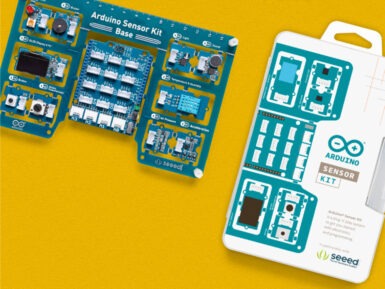What is a sensor?
A sensor is an electronic component that can measure its environment. An example of a sensor is the DHT11 sensor, which measures temperature and humidity.
What is an actuator?
An actuator is an electronic component that performs an action. An example of this is an LED, which can be turned on or off, or dimmed to a certain value.
What is a seeed module?
A seeed module is an electronic component attached to a tiny circuit board. This circuit board shares the same connector as all other seeed modules, which makes them easier to connect.
What's a grove connector?
A grove connector is a connector with four wires connected to it. They simply connect to a seeed module, and then to a seeed base shield. This removes the time spent building circuits, and allows you to connect several sensors in just minutes!
How can I use sensors and actuators in Arduino projects?
To use the seeed modules with an Arduino, we need to have a seeed base shield mounted on top of an Arduino UNO board. After it is mounted, we can easily plug in any module we want, and use the ArduinoSensorKit library to program them, using only a few lines of code!
What modules are included in the kit?
-
The LED
-
The Button
-
The Potentiometer
-
The Buzzer
-
The Light Sensor
-
The Sound Sensor
-
The Air Pressure Sensor
-
The Temperature Sensor
-
The Movement Sensor
-
The OLED Screen
Who can use the kit?
The kit is designed to be used even by the most intermediate user. The code is easy to follow and the circuitry is simplified through the use of seeed modules. The kit is also great for more advanced users that wish to reduce time on circuitry and get the job done quickly!
How does the kit work?
The kit includes everything except an Arduino UNO to work. Simply mount the base shield on top of an Arduino UNO, connect a module, and follow the instructions provided in the content platform. The platform explains how to do all of this, and includes code samples to get started with all different modules.
What's the content included?
The content in this kit includes a Getting Started tutorial, that goes through the basics of the kit, and the hardware and software requirements. Followed by that, there are 10 simple Lessons that get you started with all the seeed modules right away!
How do I access the included content?
All the content can be found in the Arduino Sensor Kit platform.
How is the Sensor Kit content structured?
All activities follow the same structure.
-
Introduction - introduces the component.
-
Plug - shows how to create the circuit.
-
Sketch - introduces the program needed for the component.
-
Play - using the component and expected outcome.
-
Understand - further reading on how the component works and related articles.
What languages does the online platform support?
English
What application can you build with the Sensor Kit?
With the components in the Arduino Sensor Kit, you can create many fun applications, such as display interfaces, sound detection, alarm system, light detection, temperature sensing and much more. You can also combine many of the sensors to create unique projects of your own.
What operating system is required?
Windows 7 or higher, Linux, or Mac OS.
What are the minimum software requirements for using the kit?
You need to download the Arduino IDE or sign up to use the Arduino Web Editor.
What are the minimum hardware requirements for using the kit?
An Arduino UNO board is required to mount the base shield on.






